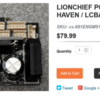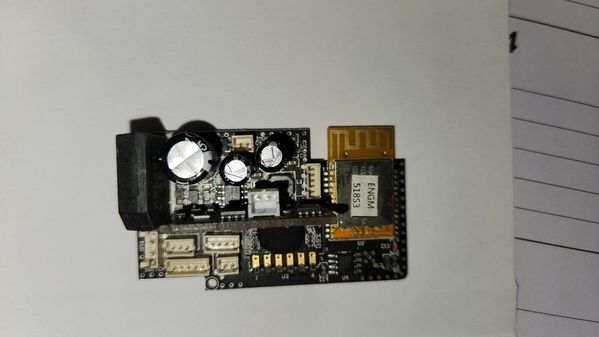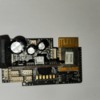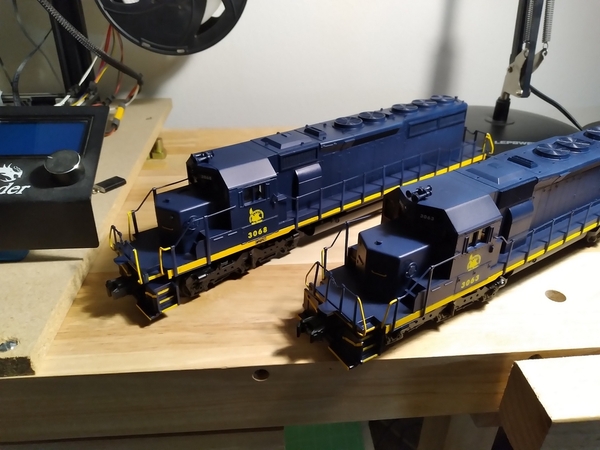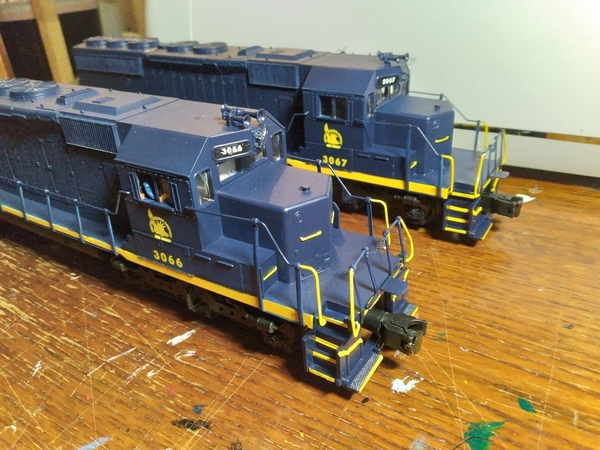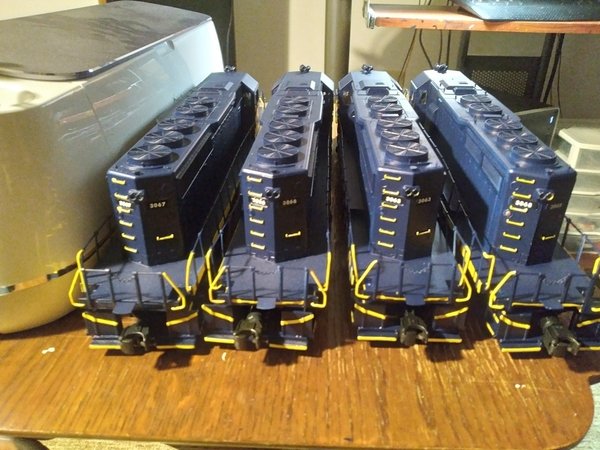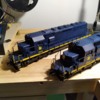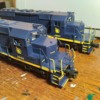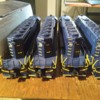@MainLine Steam posted:
Also ALL Lionchief Boards are a Single board solution, with all functionality including sound built-in, Correct?
Correct. (Not including the small boards attached to the headlight and cablight/numberboards.)Lionchief therefore can used to control direction and speed of operation, and provides operating and pre-recorded dialog sounds, along with horn and bell. Correct?
Correct.With a Lionchief board I will NOT have Electro-Couplers or Cruise, Correct?
Correct.The Universal Remote, or the remote originally sold with that board is need as a Transmitter, Correct?
Incorrect. LionChief boards from locomotives new in the the 2017 catalogs and later will have Bluetooth functionality.
See the parts diagram for a LC FT:
https://www.lionelsupport.com/...luetooth-159-6-84720
@Matt_GNo27 posted:
Thank you Matt!
I misunderstood, and thought that Lionchief Plus replaced Lionchief, not that some both systems are still offered.
Also I thought of one more question.
Please clarify that if I have a Loco with a chopper wheel and optical sensor, K-Line F7A (OEM TMCC), that I could then use a Plus Board and therefore have Cruise and Functional Electro-Couplers.
By installing boards in each F7A, they then could operate indepently, no more Lead Unit (master) Trailing Unit (slave) scenario as originally built. These Units originally have a Control and Sound Board / Speaker in the Lead Unit Only, and Motor Drivers in Each Unit. Trailing Unit shown in photo (note electro-coupler on cab-end). Have electronics "shrunk" that much and in 20 years, or is a driver board this size required to properly handle the power this unit can draw?
Attachments
Regarding the lower amperage version of the Lionchief motor driver daughter card- found in many new recent Lionchief with Bluetooth boards.

Looking those parts up, those are IRF7343 https://www.infineon.com/dgdl/...00a4015355f68c1a1b73
Key rating here is the P channel side of this dual MOSFET limited to 3.4A however dropping to 2.7 quickly at 70C temp.
Again, in an H bridge, one P channel conducts, and one N channel to drive the motor in a given direction. So the limit is the lowest device in the chain (typically the P channel MOSFET which has higher ON resistance).

VS, the older motor driver daughter card.

That driver card uses discrete components rather than these combined chip solution seen in the more recent boards.
IRF5305 https://www.infineon.com/dgdl/...00a401535632522820ff

IRLR024N https://www.infineon.com/dgdl/...00a4015356694f7f265d

This nets a worst case 12A "rating".
Now key here, this is just showing the transistors, not the circuit traces, not the bridge rectifier, not how strong the gate is driven and to what voltage, how well are the transistors heatsinked and so forth.
Attachments
@Vernon Barry posted:Regarding the lower amperage version of the Lionchief motor driver daughter card- found in many new recent Lionchief with Bluetooth boards.
Looking those parts up, those are IRF7343 https://www.infineon.com/dgdl/...00a4015355f68c1a1b73
Key rating here is the P channel side of this dual MOSFET limited to 3.4A however dropping to 2.7 quickly at 70C temp.
Again, in an H bridge, one P channel conducts, and one N channel to drive the motor in a given direction. So the limit is the lowest device in the chain (typically the P channel MOSFET which has higher ON resistance).
VS, the older motor driver daughter card.
That driver card uses discrete components rather than these combined chip solution seen in the more recent boards.
IRF5305 https://www.infineon.com/dgdl/...00a401535632522820ff
IRLR024N https://www.infineon.com/dgdl/...00a4015356694f7f265d
This nets a worst case 12A "rating".
Now key here, this is just showing the transistors, not the circuit traces, not the bridge rectifier, not how strong the gate is driven and to what voltage, how well are the transistors heatsinked and so forth.
So if I understand correctly, "to be safe", should try to use the drivers currently installed rather than rely on just plugging the motor into the Lionchief board, correct? Which I am not sure how to implement.
Think I am better off just making sure the Lionchief board I buy has the High Power Rating. How do I figure this out when purchasing a board?
@MainLine Steam posted:So if I understand correctly, "to be safe", should try to use the drivers currently installed rather than rely on just plugging the motor into the Lionchief board, correct? Which I am not sure how to implement.
Think I am better off just making sure the Lionchief board I buy has the High Power Rating. How do I figure this out when purchasing a board?
You can't use your existing motor driver parts, the LC board is kinda' an all or nothing deal.
@MainLine Steam posted:making sure the Lionchief board I buy has the High Power Rating. How do I figure this out when purchasing a board?
And there, my friend, lies the issue. https://www.lionelsupport.com/...ords=lionchief%20pcb
I know the cheaper older Lionchief RF remote only non-bluetooth boards have the higher power motor driver section. These are all the $45 boards in the list (as of today).

The issue comes in picking a newer Bluetooth enabled board. Lionel did not post pictures of the board, or in some cases a generic substitute. Nowhere in the name nor designation would you be able to know for sure. These are the $75 boards- just some examples below.

FYI, that failure picture in the previous post- that was from a http://www.lionel.com/products...onchief-set-2023010/ and this specific part number https://www.lionelsupport.com/...OOTH-0-8-0-STRASBURG
Attachments
@MainLine Steam posted:
While there have been advances, motor drivers and heatsinks are a clear indicator of capability.
Even a "good" Lionchief board has no heatsinks.
@Vernon Barry posted:While there have been advances, motor drivers and heatsinks are a clear indicator of capability.
Even a "good" Lionchief board has no heatsinks.
Thanks Vernon that is what I suspected!
I am a Mechanical Engineer not Electrical. I tell those less technically inclined, through my career I have seen a LOT of advances (probably 10 fold in electronics vs mechanical) but the laws of physics haven't changed. ![]()
@gunrunnerjohn posted:You can't use your existing motor driver parts, the LC board is kinda' an all or nothing deal.
Thank you very much John! Kinda what I figured, but now I know for sure. When I get too far into electronics I know it is better to ask an expert, than "take a guess". And I know way better, (at this point in my life), than to "just take a shot, maybe it will work". LOL
Actually, electronics has shrunk a great deal. For instance, here is the motor driver board for MTH PS/3 steam, including even the big stuff. At a little over a square inch of board, they run any motor you'd find in stuff like a 20 pound Premier Big Boy.

The Lionel RCMC is about 1.2" x 3" and includes everything but sound. The newer versions in the same footprint include sound.

Attachments
@gunrunnerjohn posted:Actually, electronics has shrunk a great deal. For instance, here is the motor driver board for MTH PS/3 steam, including even the big stuff. At a little over a square inch of board, they run any motor you'd find in stuff like a 20 pound Premier Big Boy.
The Lionel RCMC is about 1.2" x 3" and includes everything but sound. The newer versions in the same footprint include sound.
Interesting, John.
Without going "way over my head", how are they able to rectify the power without a lot of Heat Sinking required? Is it done a different way than traditional bridge circuits?
@MainLine Steam posted:Interesting, John.
Without going "way over my head", how are they able to rectify the power without a lot of Heat Sinking required? Is it done a different way than traditional bridge circuits?
The DC power is supplied to this board from the tender board through the "wireless" tether, but the boiler board has the motor driver FETs, smoke control, and all the lighting FETs.
@gunrunnerjohn posted:The DC power is supplied to this board from the tender board through the "wireless" tether, but the boiler board has the motor driver FETs, smoke control, and all the lighting FETs.
Thanks John!
On the subject of shrinkage of electronic control devices, compare the LionChief module with the new Blunami for an outstanding example of this trend.
Attachments
Gonna kick start this thread after reading through it....
I have a Weaver RS-3 New York New Haven Hartford that I recently purchased from Trainz. Seems the reversing board will only let the engine run in one direction, either forward or reverse. After some back and forth with Trainz, they offered a discount on the purchase price. It's in like new condition, and I like the older New Haven scheme, so I decided to keep it for an upgrade.
After reviewing the info here, short of a full ERR upgrade, it seems that an original LC board for an RS-3 would be an economical upgrade to get remote control and sound. A Dallee board would be more $$$ and still be just conventional. I plan to purchase a universal remote for the layout too.
Granted there's still no electro-couplers, and I don't run smoke so that's a non issue for me.
The engine has 2 vertical can motors so motor current may be an issue? Yes? My small layout doesn't allow for 20 car trains anyway.
If I've got it right, the LC+ and LC+2.0 boards require the optical sensor and flywheel for speed control so as @gunrunnerjohn said, it's a bridge to far.....
This is one of the $80.00 boards that @Vernon Barry mentioned. This will work? Or should I stick to the basic LC boards for the engine.
Bob
Attachments
Why not just put a Blunami 2200 in it? I converted my scale Williams 44 tonner with no electronics background. I have low speed control that Lionel & MTH can only dream of, great sound, and multiple lighting effects. Populating an electrocoupler board now to add. All this for less than $150.
@Trainmstr posted:Why not just put a Blunami 2200 in it? I converted my scale Williams 44 tonner with no electronics background. I have low speed control that Lionel & MTH can only dream of, great sound, and multiple lighting effects. Populating an electrocoupler board now to add. All this for less than $150.
I've considered Blunami but I've decided to hold off on a 3rd control system for now. I'll stay with Lionel and MTH for the near term. I'm not a huge fan of tablets and phones for control either. Don't hate it, I use the LC app frequently, I just prefer a remote in hand......must be a sign of getting old.........![]()
@geepboy posted:To my very limited knowledge there is no way to add all of the Lionel Lionchief capabilities to a non-Lionel loco. I'm looking for a way to easily remotely control a loco which only has conventional control. For me, that's Lionchief Plus. I know there's a DCC way or maybe even a Legacy way but I have no interest in that.
So, as far as I know, if I want Lionchief, I must purchase Lionel. Is my understanding correct?
Dan
I'd look at other simpler and more proven options for these conversions to remote control.
First, if you can live with controlling track voltage, direction, horn, and bell remotely, a Lionel Powermaster between the transformer and track and a Cab-1 provide this for conventional operations. No electrocouplers and no controlling the locomotive directly in what's known as "command control" but this simple, lowest-cost alternative satisfies many.
Next, I'd simply look at buying new-old-stock and used original TMCC locomotives in traditional size. These are relatively plentiful, fairly reliable, and fairly inexpensive. For example, I believe I saw a forumite put a TMCC-equipped 0-4-0 switcher for $150. I've purchased nicely used TMCC engines for $200. Good supply out there generally under $300.
For an actual conversion, I've had several modern conventional Williams engines converted to ERR TMCC. Bullet-proof but no longer inexpensive.
The latter two options bring full command control and electrcouplers, better than newer Lionchief, on par with Lionchief Plus, and a shade behind Lionchief Plus 2.0 but a lot cheaper.
@RSJB18 posted:This is one of the $80.00 boards that @Vernon Barry mentioned. This will work? Or should I stick to the basic LC boards for the engine.
This board will work fine, it's a plain LC with BT, and should drop right in. Obviously, you have to sort out the connectors...
@gunrunnerjohn posted:This board will work fine, it's a plain LC with BT, and should drop right in. Obviously, you have to sort out the connectors...
Thanks John. I will take another look at the parts site, some of the board pix show what each plug is for.
Bob
I received the LC/BT board for my Weaver RS3 today. I had ordered it a couple weeks ago but Lionel shipped me the board for the remote, not the engine.
All of the plugs are labeled on the board! YAY! ![]()
Looks like these boards have only one motor output (white plug on the vertical board), so running 2 can motors through it might be a stretch. I'll do some testing and see what the current draw is before putting it all together.
Now to make time to work on it.....
Top plug is smoke (Maybe a cab light or strobe?)
Top right- (not sure but.....labels are: GND, RST, +3.3V, CLK, DAT). Maybe not used on this engine?
Large white plug in center- motor output
Bottom left vertical- board power
Bottom horizontal- switch and speaker
Top horizontal- chuff and lights
Attachments
The boards frequently run two motors, but note that some Weaver (and Williams) diesels are notorious for having motors that draw a lot of current.
@RSJB18 posted:
Yes, at some point Lionel changed the PWM H bridge motor drive daughter card production. This is the weak point of the board now.
This new design use:
Looking those parts up, those are IRF7343 https://www.infineon.com/dgdl/...00a4015355f68c1a1b73
Key rating here is the P channel side of this dual MOSFET limited to 3.4A however dropping to 2.7 quickly at 70C temp.
Again, in an H bridge, one P channel conducts, and one N channel to drive the motor in a given direction. So the limit is the lowest device in the chain (typically the P channel MOSFET which has higher ON resistance).
I've lost count now of how many dead boards have crossed my repair desk with this new style board with the weaker motor drive components.

Previous designs used larger discrete components capable of much higher sustained and even peak motor current.


Attachments
Again, to be fair, Lionel is using the new design on all new product I have seen go through our shop and local purchases- meaning they use it for example in those new Lionchief dual motor Dash 8, the dual motor ET44 Lionchief, and so on.
So yes, they do use it with dual motors- but they are small motors and lower current.
And, I've seen failures in even single motor locos (example a General) that somehow jammed the driveline and the user kept trying to run it until it popped.
I am trying to follow this thread, but somewhat confused. I would like to do the same thing.
My understanding the board RSJB18 has is rated (safely) for 2.7 Amps max, correct? When wiring the 2 motors to the board, should they be wired in series or parallel? Does it make a difference in not overloading the board? I like to run scale speeds, not race around in circles.
Please let me know. Thank you!
@MainLine Steam posted:I am trying to follow this thread, but somewhat confused. I would like to do the same thing.
My understanding the board RSJB18 has is rated (safely) for 2.7 Amps max, correct? When wiring the 2 motors to the board, should they be wired in series or parallel? Does it make a difference in not overloading the board? I like to run scale speeds, not race around in circles.
Please let me know. Thank you!
Series wiring of the motors results in less current draw and slower speed. You kind of have to test each application. Example, you may find wiring in series- simply the motors run too slow even wide open throttle (Lionchief throttle) at 18V track voltage.
@Vernon Barry posted:Series wiring of the motors results in less current draw and slower speed. You kind of have to test each application. Example, you may find wiring in series- simply the motors run too slow even wide open throttle (Lionchief throttle) at 18V track voltage.
Thank you very much!
My understanding is that Lionchief boards can operate on DC power, is that correct or does it only apply to certain boards? I am planning on running battery powered.
Currently operating a pair of Weaver EL U25b's with LC board and controller from LC NYC RS3. Both run like a top. Easy upgrade.
Each has same LC board donator so can run with 1 controller...doubleheading!
Walter
@MainLine Steam posted:Thank you very much!
My understanding is that Lionchief boards can operate on DC power, is that correct or does it only apply to certain boards? I am planning on running battery powered.
Lionchief boards can run AC or DC so yes, can use with DC or battery power.
@Walter Matuch posted:Currently operating a pair of Weaver EL U25b's with LC board and controller from LC NYC RS3. Both run like a top. Easy upgrade.
Each has same LC board donator so can run with 1 controller...doubleheading!
Walter
I have a Weaver FA/FB set (late production with dual vertical motors in each unit). Never had even thought of what you are doing, that is brilliant! Makes it so easy. Thank you.
@Vernon Barry posted:Lionchief boards can run AC or DC so yes, can use with DC or battery power.
Thank you very much for helping me with this. I can determine voltage required to make it acceptable by running 3R DC and then use the correct battery pack.
@MainLine Steam posted:Thank you very much for helping me with this. I can determine voltage required to make it acceptable by running 3R DC and then use the correct battery pack.
FWIW, on the bench I test Lionchief boards with a 9V battery. I would consider that the low end of the workable range with 18V being the recommended maximum. Lionchief sets ship with an 18V DC supply.
@Walter Matuch posted:Currently operating a pair of Weaver EL U25b's with LC board and controller from LC NYC RS3. Both run like a top. Easy upgrade.
Each has same LC board donator so can run with 1 controller...doubleheading!
Walter
Walter- what motors are in the U25's? My RS3 has vertical can motors. I don't have it open right now to check on the model #.
@MainLine Steam posted:I have a Weaver FA/FB set (late production with dual vertical motors in each unit). Never had even thought of what you are doing, that is brilliant! Makes it so easy. Thank you.
That's what I was thinking too. I have a few nicer conventional locos that I'd like to make command capable without dropping major money on ERR or PS3/2 boards. I'm hoping this is a good middle of the road solution.
Bob
@gunrunnerjohn posted:The boards frequently run two motors, but note that some Weaver (and Williams) diesels are notorious for having motors that draw a lot of current.
Mine is from the 2011 catalog. Not the older chain/belt drive.
@RSJB18 posted:Walter- what motors are in the U25's? My RS3 has vertical can motors. I don't have it open right now to check on the model #.
The motors are doubtless the Mabuchi 3xx series, probably the RS385's.
@gunrunnerjohn posted:The motors are doubtless the Mabuchi 3xx series, probably the RS385's.
Thanks John. I'm sure I'll make my way to the basement later. I'm anxious to get this going.
This is the topic I created a couple of years when I bought my Weaver FA/FB Set.
https://ogrforum.ogaugerr.com/...ou-think-please-help
I will take them out and find out what motors they have. I now have a loop of track with a 1950's era KW that I can run them on.
Motors are RS-385PH made in China. They are wired in Parallel. I need to take apart and lube, but at this point at full throttle (20VAC) they do not run very fast (appear they are NIB).
These are not at the top of my list for conversion as they are TMCC with Sound and Cruise and work OK Conventionally. I do not have TMCC, if anyone is interested I might be able to take them and try them out on a TMCC Layout.
@MainLine Steam posted:Thank you very much for helping me with this. I can determine voltage required to make it acceptable by running 3R DC and then use the correct battery pack.
14.8v Lithium Ion (Li-Ion) would be an excellent choice for a great majority of O Gauge engines. Get the largest mah that will fit your engine or tender. I use anything from 2200 - 3200 mah.
Make sure you get a Li-Ion with PCB for protection from under and over current. A simple and cheap smart charger works great with them. Avoid Li-Po batts if possible. The extra balance lead and special charging requirements make it very difficult for onboard charging.
Ron
Doing another transplant with 6 Weaver SD-40s. 3 each will have same LC 'brains' so I can run triple-header CNJ SD-40s. Yes they all have been repainted into roadnumbers not issued by Atlas or Lionel.
Pretty soon more 6 motors on the O-gauge BIG little Railroad.
Doing the transplant is easier than TMCC/ERR/PS-3 upgrades in my opinion and like poster RSJB18 above said.
Walter













 ,
,
